In November, the Sana’a Center organized a visit by an international press delegation to Yemen’s Shabwa governorate. This was the third such trip the center has arranged, with previous ones being to Marib and Hadramawt, and came as part of the Sana’a Center’s continuing commitment to ensure the world, through its media, has a window onto Yemen – given the international press’ restricted access to the country due to the ongoing war and pandemic. Ryan Bailey, an editor and researcher with the Sana’a Center based outside the country, traveled to Shabwa with the delegation and documented their tour around the governorate and those they met during his first trip to Yemen.
Day 1 – Arrival
It is early evening when our Yemenia Airways flight touches down at Sayoun airport. I walk down the stairs into the warm desert air in a long line of Yemeni families, our delegation of international journalists, and a smaller group of international students on their way to study at Dar al-Mustafa, a renowned Sufi Islamic center in the nearby town of Tarim.
This moment nearly didn’t happen. Earlier in the day our tickets had been canceled only a few hours before our scheduled takeoff at Cairo airport, leaving us scrambling. We at the Sana’a Center had been planning this trip for months, lining up permissions, checking boxes, and taking COVID-19 tests, but apparently someone in the Yemeni government or the Arab coalition that controls Yemen’s skies had second thoughts about allowing a bunch of western journalists into the country. As the clock ticked down on our departure time the Sana’a Center’s chairman Farea and executive director Maged worked the phones, cajoling, threatening, schmoozing, asking for favors and calling in owed ones, until finally we managed to delay the flight for an hour – enough time to secure renewed permission, board the plane, buckle in and take off.
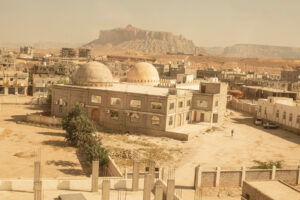
After customs and a baggage inspection at Sayoun, we are led into a sideroom: it’s time to eat. On a plastic sheet covering the floor sits large round plates piled with rice beneath roasted lamb, served alongside delicious malawach (Yemeni flatbread) and sahawiq (an incredible version of Yemeni salsa). Later, satiated from the delectable meal and still a bit disoriented from the flight, our group of 16 piles into four armored SUVs, for the six-hour drive through the darkness to Ataq. Our trip will take us through Hadramawt and what I’m told is stunningly bleak and beautiful terrain to the capital of Shabwa’s governorate. The SUVs arrange themselves into a convoy and our escorts – Yemeni national troops, local Shabwani security forces and armed tribal men in technical vehicles – fall in around us. I’m too wired to sleep, and spend much of the drive gazing out the windshield at the guard vehicle in front of us, wondering about and feeling sympathy for the armed men crammed together in the back of the pick up truck ahead of our vehicle.
Al-Qaeda elements are still present in the Wadi Hadramawt area around Sayoun, so we want to get through the area quickly. The bulletproof windows in the armored cars don’t roll down, and there’s not much to see behind the tint out into the night, save for rudimentary checkpoints.
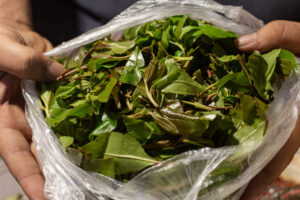
Several members of our group chew qat to pass the time. I’m given a tutorial by Ammar, one of the main organizers of the trip, who hails from a prominent Shabwani family, on how to best prune the shrub before sticking stem and leaves into my mouth, and chewing to form a ball in my cheek. The qat is bitter at first, but I soon get used to, and even begin to enjoy, the taste of the mild narcotic. Our car even samples several varieties, with the juiciest qat being from Yemen’s northern governorate of Sa’ada, the home of the Houthi movement.
I can tell we’ve reached Shabwa by the change in the road. In Hadramawt the highway was cracked and pot-holed, at times giving way to dirt or berms of sand. Shabwa’s is smooth asphalt. We’re ascending slightly as we near Ataq. I can’t really feel it, but the popping in my ears tells me we’re climbing toward the city more than 1,100 meters above sea level.
Finally, we see the lights of Ataq’s main boulevard in the distance. That’s one of the first things you notice in Yemen: the lack of lights. We’ve been driving for hours and these are some of the first lights we’ve seen.
The road into town is lined with pictures of President Abdo Rabbu Mansour Hadi, which appear new and posted for the convoy to see, and Governor Mohammed Saleh bin Adio. This is Ataq, our home for the next week.
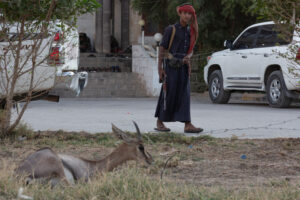
Day 2 – The Governor
We wake early at Al-Fakhamah hotel, pile into cars, and weave through Ataq’s morning traffic to the heavily guarded governor’s residence. Pulling into the compound, I see a number of tiny toy-like gazelles grazing on the lawn. A gift to the governor from one of Shabwa’s tribes, I later learn.
We are greeted at the entrance by the governor himself and a number of other local dignitaries. Bin Adio speaks slowly and deliberately, necessitating the audience to listen carefully to his words. Like any good politician, he stresses the local authority’s accomplishments and focus on development, particularly in terms of roads, electricity and healthcare. The governor is rightly proud of what his team has accomplished in the midst of a war, and mentions that the new hospital in town has been constructed with the 20 percent share of Shabwa’s oil and gas revenue that the local authority negotiated with the central government. Because the soon-to-be-opened hospital was built with local funds it will sit under local authority, not under the national Ministry of Health. Most of this building boom, however, has been orchestrated from the top, with contracts for buildings and road paving awarded without a competitive tender process.
Lunch in a large basement room of the governor’s residence is another feast. Lamb, rice, fresh fruit, vegetables and a local dish, baby shark.
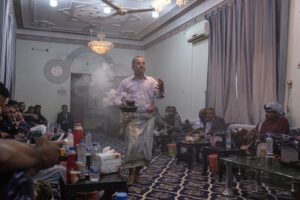
After eating, it’s time for a qat chew in the governor’s diwan. Sitting on long couches, which ring three sides of the room, the governor and his team take turns explaining the ongoing struggle between the Yemeni government and the Southern Transitional Council (STC), which is backed by the United Arab Emirates. Last August, the two came to blows, with the STC taking control of Aden and heading east. But the STC offensive was broken in Ataq, where local tribes and government forces combined to defeat the UAE-backed Shabwani Elite forces and end the separatists’ bid to extend their control across southern Yemen.
Since the STC’s defeat last year, Shabwa has been under almost complete government control. The only exceptions are two bases that still house Emirati forces: Al-Alam camp north of Ataq, and the Balhaf liquid natural gas terminal, the largest investment project in Yemen’s history. At the latter, the UAE maintains a mixed presence of 1,000 troops, about 200 Emirati soldiers and 800 Shabwani Elite troops. Bin Adio’s dislike for the Emiratis is obvious.
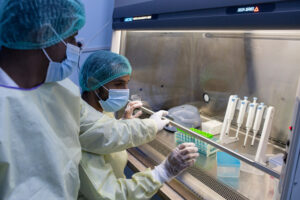
Day 3 – COVID-19
Today we try to tackle one of the most pressing questions of our trip: what exactly happened to COVID-19 in Yemen? Is the country through it, in a trough, about to get hit again?
Our first visit of the day is to Ataq general hospital. Here, doctors and hospital staff dutifully relay a litany of challenges facing the health sector: a critical shortage of staffing, supplies and equipment as the hospital strives to treat a growing number of cases of severe pediatric malnutrition, cholera, diphtheria and dengue fever.
Given these other maladies, COVID-19 isn’t at the top of staff’s worries. The doctors we speak to say there was an initial spike in cases earlier in the year, but that the virus appears to have receded and nearly disappeared in recent months.
After the hospital, we visit the brand new COVID-19 quarantine and testing center. Here we are told that the facility is one of the best equipped in the country but has not recorded a confirmed case of COVID-19 since August. How is this possible, particularly given the scant attention paid to precautions such as mask-wearing and social distancing in Shabwa?
There are a lot of theories, but no real answers. Some speculate that COVID-19 can’t survive in a warm climate, or maybe Yemen’s relatively young population may have helped it escape the worst. Others argue for strong Yemeni immune systems or good local morale. My favorite explanation for why coronavirus has not taken hold in the war-ravaged country came from Governor Ben Adio: “God has never given two misfortunes.”
We cap off our day watching the sunset from a plateau outside Ataq. Various plateaus line the desert from Shabwa to Hadramawt, and the winding trip to the top on the narrow, single-lane road proves more than worth the occasional hair-raising moment. The sublime red Arabian sunset provides an opportune moment for quiet contemplation.
(Editor’s note: On December 6, Shabwa recorded its first confirmed case of COVID-19 in months.)
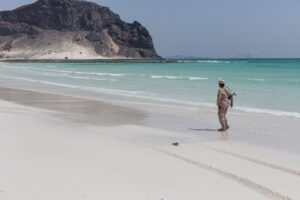
Day 4 – The Coast
Today is Friday, the start of the Yemeni weekend, so we head south to the coast. Our destination is the Balhaf LNG terminal. The site has not been operational since the start of the conflict and is a major source of the tensions between bin Adio and the UAE. The governor, who says “the UAE did not give us a single bullet to fight the Houthis,” wants the Emirati forces out, foreign oil companies back, and operations restarted. But the Emiratis don’t look like they’re going anywhere.
In addition, questions remain over the appetite for international oil companies to return to Yemen at the current time, even with the relative security in Shabwa. Austrian OMV, which operates an oil field in Shabwa’s Habban district, became the first international oil company to resume operations in the country in 2018, but thus far none of the partners in the Balhaf project, most notably French Total, have indicated they would be ready to restart operations.
Traveling down south we hurtle toward the Arabian Sea. At one point, we reach an intersection that branches west toward Aden and east toward Mukalla. This was the farthest point Houthi forces reached in Shabwa in 2015, before being turned back by the Saudi- and Emirati-led military coalition and finally expelled from the governorate in 2018. We turn east, driving through Azzan, which Al-Qaeda militants held in 2011 and 2012, and again for a brief period in 2016. So many different wars over the same terrain.

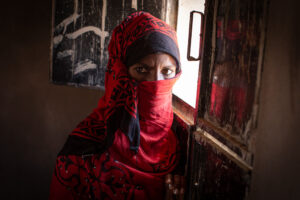
Green starts to appear as we near the coast, small river beds feeding shockingly lush patches of vegetation. Our convoy passes several groups of African migrants, who pay smugglers to bring them to Yemen’s coast in hopes of crossing the country and making it to Saudi Arabia. On the coast everything appears sharply defined and clear. To the left are dunes of sand, an occasional camel wandering into sight. To the right, the Arabian Sea. Creeping toward Balhaf, black volcanic rock also makes an appearance in the distinctive landscape.
Our initial plan to enter the Balhaf facility falls through. The UAE and governor’s office would later exchange blame for the lack of coordination related to our visit.
Instead we head to a pristine stretch of beach at Bir Ali, an ancient seaport that aspiring locals dream of turning into a resort. There we hear about plans for the seaside development, which the project manager hopes will eventually cater to both Yemeni tourists and foreign visitors. A few of us can’t resist jumping in the sea for a quick swim, and waist-deep in the emerald blue water, that almost seems possible.
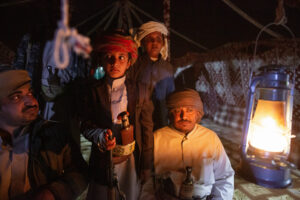
Day 5 – The Desert
Just before sunset we leave Ataq and head to the desert for a meeting of tribal sheikhs. Over cups of sweet tea, we listen as they explain Shabwa’s tribal history and customs, and the integral role tribes play in a society with a weak central state. This isn’t just history. It was the tribes that turned the tide on the STC advance in August 2019 – with tribes on both sides they refused to fight among themselves and forced the STC to retreat back toward Aden.
Dinner is more succulent lamb. While eating we learn that in some tribes custom dictates the host be given a certain part of the lamb, who then gives it to the person who cooked the meal. Known as assaybah (literally translated as ‘doing the right thing’), the challenge is that this reserved cut of meat can differ from tribe to tribe, and region to region. The guest better figure it out, however, because failing to honor this tradition would be considered quite the faux pas in tribal society. While foreigners may get a pass, a Yemeni would never be exempt from understanding and honoring such unspoken, and sometimes contradictory, rules. For dessert, there is Masoobah, spongy soft bread in a bowl smeared with honey. This part of the meal especially necessitates that we experience washing our hands the tribal way. Rubbing them in the sand, we make our way over to a tanker truck and rinse them with water coming out of a spout at the back into a bathtub basin.
After exchanging farewells with our gracious hosts, we scatter to our various vehicles and under the starry sky our convoy flies over the sand back to Ataq.
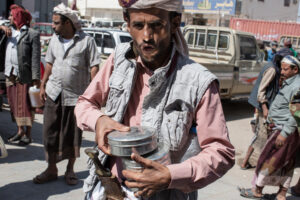
Day 6 – The Souk
Sunday morning starts with a visit to the Ataq souk. The road there takes us past a large shantytown, home to muhamasheen, literally “the marginalized ones,” and the bottom of Yemen’s traditional social pyramid. Reaching Ataq’s old city, we pass several buildings dating to South Yemen’s socialist era. If you look closely, there is still an outline of a red star on some facades.
At the souk, honey is the main item on offer. The local variety, derived from the nectar of sidr trees, is considered among the best in the world, and Shabwanis are rightly proud of it. Locals will tell you Shabwani honey is the best in Yemen, and laugh off challenges from others claiming Wessab or some other location to be the paramount producer in the land. A few samples in, local sellers explain that roughly half of Shabwa’s honey is exported abroad, helping producers pocket on average between US$40,000 and $70,000 during the three-to-four month harvesting season.

Day 7 – Bees
The next morning, we set off to see honey farmers in action. We pull into a stretch of land, off Ataq’s main road, and find several men crouched over a line of drawers, each filled with a beehive. Bees swarm around the heads of the workers, who set alight tiny pieces of burlap that give off smoke to pacify the bees as they pull honey.
The owner of the apiary, who says he got into the bee business after using his savings to purchase several hives a few years ago, kindly explains how he transports them, bringing his bees to wherever the best sidr trees are blossoming at the time. Beekeepers coordinate over WhatsApp, sharing tips and comparing notes on the proper geographical distribution of bees to produce the best yield.
Back at the car, Salem, our driver and Governor Bin Adio’s personal secretary, says he recognizes the bee farmer. He was detained a while back, and “held for six months as an Al-Qaeda sympathizer.” The information is both jarring and comically absurd, and we share a laugh in thanks over his career change.
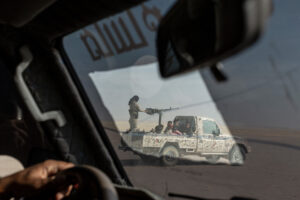
Day 8 – Road trip
Leaving Yemen is complicated by our initial ticket cancellation a week earlier, so after some debate it is decided that we should drive out via the country’s eastern border with Oman, 20 hours away. Our entire group registers negative PCR tests – hamdallah – so we and our armored convoy leave Ataq around 6 a.m. After having chewed all through the night before, I sleep for much of the journey, eventually waking as we begin a stark and winding ascent from Wadi Hadramawt on a road flanked by two canyons. With several hours left before the border, again I start to dose, with images of the desert dancing in my mind.
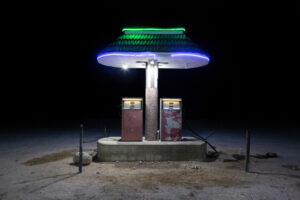
Ryan Bailey is an editor and researcher at the Sana’a Center for Strategic Studies.
This article first appeared in Time for a New US Policy – The Yemen Review, November 2020
The Sana’a Center for Strategic Studies is an independent think-tank that seeks to foster change through knowledge production with a focus on Yemen and the surrounding region. The Center’s publications and programs, offered in both Arabic and English, cover diplomatic, political, social, economic and security-related developments, aiming to impact policy locally, regionally, and internationally.

 اقرأ المحتوى باللغة العربية
اقرأ المحتوى باللغة العربية